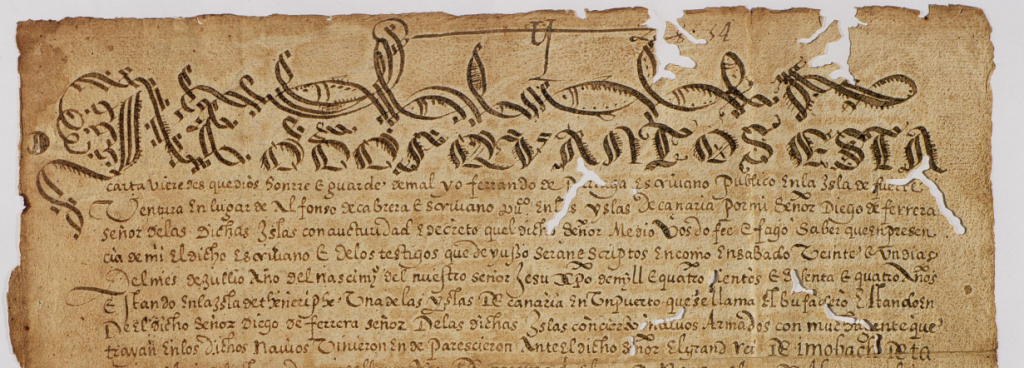
An example of a public document relevant to the ancient history of the Canary Islands: a fragment of the only-known copy of the so-called Treaty of Bufadero (source: Archivo Histórico Provincial de Santa Cruz de Tenerife, Historical Section of Notarial Protocols , 1178 , fol . 55r )
Under The Essentials epigraph we intend to widespread a series of documents we consider to be cornerstones in understanding the ancient history of the Canary Islands.
Generally, we will classify them in:
- CHRONICLES:[1]For the sake of simplicity we will not distinguish among chronicles and accounts. For more details, please consult MORALES (1978), pp. 39-55.
- Stories that narrate the events that took place during the conquest of the Archipelago from an European perspective.[2]Unfortunately, unlike the case of the conquest of America, there is no account of the conquest of the Canary Islands from the indigene point of view.
- They feature a markedly subjective mood, medieval style and the authors’ intention is usually extolling the role played by one or more of the conquerors.
- The authors have participated in the events described or referred directly to some of the people who played a role in or witnessed these events, from whom they receive the information needed to compose the texts.
- The value of these documents lies, rather than in their objectiveness and accuracy, in the general perspective offered on the process of conquest and the limited but valuable insights into the indigenous world that they provide, even without reaching the category of authentic ethnographic studies and despite of the distortions introduced by the colonial filtering.
- In the Canary Islands case, we could classify the chronicles in:
- CANARIAN CHRONICLES: specifically devoted to the conquest of the Archipelago –for example, Le Canarien–.[3]SERRA (1960); SERRA (1965).
- EUROPEAN CHRONICLES: whose primary purpose is to describe events that occurred in Europe, but they contain also one or more chapters devoted to the conquest of the Canaries –for example, Alonso de Palencia’s Decades–[4]LÓPEZ (1970)..
- HISTORIES:
- Written by post-conquest authors.
- The information required to compose them comes from ancient documents, classical authors, the folklore and the testimony of descendants of people who played some role in the conquest, among other sources.
- The authors introduce new cultural filters by writing from the perspective of a long time after the events.
- They usually give greater importance to ethnographic elements than the chronicles.
- Example: History of the Conquest of the Seven Islands of Grand Canary, by Brother Juan de Abreu Galindo.[5]ABREU (1848).
- PUBLIC DOCUMENTS:
- These are documents written and / or signed by scribes or notaries and therefore endowed with official endorsement –wills, informations of nobility, royal charters, contracts, etc.–.
- They have great historiographic value as they shed light on events with a greater degree of objectivity and chronological accuracy.
- Example: the public dossier known as Cabitos’ Inquiry.[6]AZNAR (1990).
- STUDIES:
- These are academic/scientific works analyzing the ancient history of the Canary Islands from the documentary and / or archaeological evidence, which might also provide new evidence or hypotheses to explain certain events.
- These usually adopt either an assay, book or article format, but sometimes also presented in the form of introduction to modern editions of classic texts.
- Example: The “harimaguadas”, a peculiar rite of initiation of Gran Canaria island, by Francisco Pérez Saavedra.[7]PÉREZ (1996).
NOTE: Spanish work titles translated by PROYECTO TARHA.
Antonio M. López Alonso
REFERENCES
- Abreu Galindo, Fr. J. de. (1848). Historia de la conquista de las siete islas de Gran Canaria. Imprenta, Litografía y Librería Isleña.
- Aznar Vallejo, E. (1990). Pesquisa de Cabitos. Cabildo Insular de Gran Canaria.
- López de Toro, J. (1970). La conquista de Canarias en la “Cuarta Década” del cronista Alonso de Palencia. 1478-1480. Anuario de Estudios Atlánticos, 1(16):325–393.
- Morales Padrón, F. (1978). Canarias: Crónicas de su conquista. Ayuntamiento de Las Palmas de Gran Canaria – El Museo Canario.
- Pérez Saavedra, F. (1996). Las harimaguadas, rito de iniciación peculiar de la isla de Gran Canaria. Anuario de Estudios Atlánticos, 1(42):129–152.
- Serra Ráfols, E. y Cioranescu, A. (1960). Le Canarien. Crónicas francesas de la conquista de Canarias. II. Texto de Juan V de Bethencourt. Instituto de Estudios Canarios – Consejo Superior de Investigaciones Científicas – El Museo Canario.
- Serra Ráfols, E. y Cioranescu, A. (1965). Le Canarien. Crónicas francesas de la conquista de Canarias. III. Texto de Gadifer de La Salle. Apéndices e índices. Instituto de Estudios Canarios – Consejo Superior de Investigaciones Científicas – El Museo Canario.
